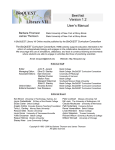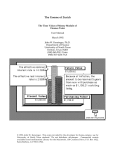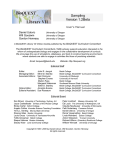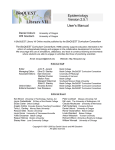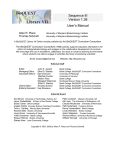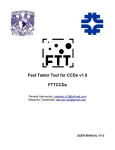Download MacRetina Version 2.2 User`s Manual
Transcript
MacRetina Version 2.2 User’s Manual Richard F. Olivo Smith College A BioQUEST Library VII Online module published by the BioQUEST Curriculum Consortium The BioQUEST Curriculum Consortium (1986) actively supports educators interested in the reform of undergraduate biology and engages in the collaborative development of curricula. We encourage the use of simulations, databases, and tools to construct learning environments where students are able to engage in activities like those of practicing scientists. Email: [email protected] Website: http://bioquest.org Editorial Staff Editor: Managing Editor: Associate Editors: John R. Jungck Ethel D. Stanley Sam Donovan Stephen Everse Marion Fass Margaret Waterman Ethel D. Stanley Online Editor: Amanda Everse Editorial Assistant: Sue Risseeuw Beloit College Beloit College, BioQUEST Curriculum Consortium University of Pittsburgh University of Vermont Beloit College Southeast Missouri State University Beloit College, BioQUEST Curriculum Consortium Beloit College, BioQUEST Curriculum Consortium Beloit College, BioQUEST Curriculum Consortium Editorial Board Ken Brown University of Technology, Sydney, AU Joyce Cadwallader St Mary of the Woods College Eloise Carter Oxford College Angelo Collins Knowles Science Teaching Foundation Terry L. Derting Murray State University Roscoe Giles Boston University Louis Gross University of Tennessee-Knoxville Yaffa Grossman Beloit College Raquel Holmes Boston University Stacey Kiser Lane Community College Peter Lockhart Massey University, NZ Ed Louis The University of Nottingham, UK Claudia Neuhauser University of Minnesota Patti Soderberg Conserve School Rama Viswanathan Beloit College Linda Weinland Edison College Anton Weisstein Truman University Richard Wilson (Emeritus) Rockhurst College William Wimsatt University of Chicago Copyright © 1993 -2006 by Richard F. Olivo Copyright, Trademark, and License Acknowledgments Portions of the BioQUEST Library are copyrighted by Annenberg/CPB, Apple Computer Inc., Beloit College, Claris Corporation, Microsoft Corporation, and the authors of individually titled modules. All rights reserved. System 6, System 7, System 8, Mac OS 8, Finder, and SimpleText are trademarks of Apple Computer, Incorporated. HyperCard and HyperTalk, MultiFinder, QuickTime, Apple, Mac, Macintosh, Power Macintosh, LaserWriter, ImageWriter, and the Apple logo are registered trademarks of Apple Computer, Incorporated. Claris and HyperCard Player 2.1 are registered trademarks of Claris Corporation. Extend is a trademark of Imagine That, Incorporated. Adobe, Acrobat, and PageMaker are trademarks of Adobe Systems Incorporated. Microsoft, Windows, MS-DOS, and Windows NT are either registered trademarks or trademarks of Microsoft Corporation. Helvetica, Times, and Palatino are registered trademarks of Linotype-Hell. The BioQUEST Library and BioQUEST Curriculum Consortium are trademarks of Beloit College. Each BioQUEST module is a trademark of its respective institutions/authors. All other company and product names are trademarks or registered trademarks of their respective owners. Portions of some modules' software were created using Extender GrafPak™ by Invention Software Corporation. Some modules' software use the BioQUEST Toolkit licensed from Project BioQUEST. DESCRIPTION of MacRETINA MacRetina simulates an experiment in which students record from retinal ganglion cells, the cells in the retina that send information from the eye to the brain. By sampling neural activity while stimulating with small spots of light, students can see the dynamic excitatory and inhibitory responses of these neurons, and map the organization of the retinal region that drives each cell (the cell's receptive field). Ten cells are modeled. Their overlapping receptive fields show how a visual stimulus is detected by many neighboring ganglion cells. MacRetina's • • • • • main features: MacRetina is a realistic simulation of a lab experiment that would otherwise be beyond the reach of undergraduates. It is modeled accurately on published data. It does not provide "right" answers, just as real experiments do not have hidden right answers. MacRetina does allow the students in a class to map the same set of cells and then compare their results, to allow students to see if their work is consistent with what others find. Version 1 of MacRetina received a "Distinguished Natural Sciences Software" Award in 1992 from EDUCOM. Version 2 adds new features that were widely requested by users of Version 1. Instructional objectives: MacRetina is intended for undergraduates in intermediate and upper level courses in neuroscience, neurobiology, physiological psychology, and perception. It is a simulated laboratory experiment, not a tutorial (though it does contain a brief tutorial and additional text material), and it is best used after students have heard a lecture or read a chapter about the retina. In most cases students can use MacRetina on their own time in a central Macintosh cluster or at home, although it has also been used during laboratory periods and as a lecture-demonstration. After working with MacRetina, students should be able to: • Turn in printed maps of up to ten retinal ganglion cell receptive fields, with each cell classified by center type (on or off) and by response dynamics (sustained or transient). • • • Describe the difference between on-center and off-center ganglion cells. Describe the difference between sustained and transient responses from ganglion cells. Evaluate the way the visual image is analyzed simultaneously by many neurons acting in parallel. A BRIEF TUTORIAL MacRetina simulates an experiment in which you record from certain nerve cells in the eye of the cat that send information from the retina to the brain. These cells are called retinal ganglion cells, and their axons form the optic nerve. For the experiment, the cat has been placed under anesthesia, with its eyes open, facing a blank screen on which a light or dark stimulus spot can be projected. Recording Action Potentials from a Single Neuron To sample the activity of a retinal ganglion cell, a fine needle electrode is inserted into the retina until its tip lies next to one cell. the electrode is connected to a preamplifier, which in turn is connected to an oscilloscope and a loudspeaker. Action potentials that are picked up from the ganglion cell appear as vertical lines (spikes) on the oscilloscope, as seen above, and are heard as clicks. Spontaneous Activity Retinal ganglion cells fire action potentials at a low rate even when no visual stimulus falls on the retina. You are now seeing and hearing spontaneous neural activity (spikes) from the first retinal ganglion cell in this experiment. The spikes occur at random times, sometimes in brief bursts. Later, when you visually stimulate the cell, you must distinguish real excitation or inhibition from the spontaneous variations. Placing a Stimulus on the Retina The gray region represents a tiny area of retina, 0.5 x 1.0 mm in size. Spots of light that are projected onto the screen in front of the animal are focused onto this area of the retina by the optics of the eye. You move the spot by moving the mouse, and you turn the spot on or off by pressing or releasing the mouse button. You will have to turn on the spot and sweep it round to find where to stimulate a cell. Mapping Receptive Fields with Spots of Light When the stimulus spot is in a particular region of the retina for each cell (but only there), the cell will fire at a high rate. That region is the excitatory part of the cell's receptive field, described further in the Help file called Retinal Ganglion Cells. You are now seeing the white stimulus spot. In an experiment, moving the spot in the retinal area will leave a dot at the spot's location each time the cell fires a spike. Using the Controls and Menus The control panel on the right lets you switch to single-sweep mode (Single), where the trace freezes at the end instead of erasing itself; trigger a new single sweep (Start); select between light and dark spots as stimuli; and select a pencil or eraser for drawing (you must also hold down the Command/Apple key). You access other controls through menus, which you can read about in the Help file called Menu Choices. What to do Next Map the receptive field of the first ganglion cell by slowly sweeping the white stimulus spot back and forth across the retina until you find a region that excites the cell. (Hint: cell 1's excitatory region is near the center of the retinal area.) You will also find a surrounding area like a doughnut where light inhibits cell 1. "Paint" the cell's field, save the map, then move the electrode to other cells to map them. MacRETINA'S HISTORY MacRetina was developed with the advice of faculty members teaching courses in neurobiology, physiological psychology, and perception. Their names are given in the "Credits" file under the Help menu. Version 1 of MacRetina received a "Distinguished Natural Sciences Software" award in 1992 from EDUCOM. Version 2.0 added several new features, the most important of which were the ability to save and restore maps of receptive fields, provision of a dark spot as a stimulus, and an introductory tutorial for students. Versions 2.1 and 2.2 substituted a newer method of generating sounds, and fixed several minor bugs. MacRetina is distributed by The BioQUEST™ Library and by the Intellimation Library for the Macintosh.







